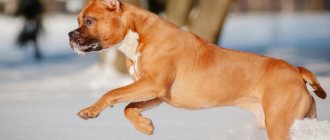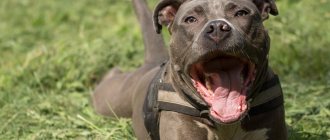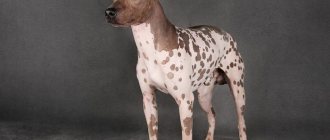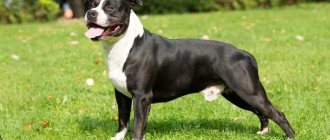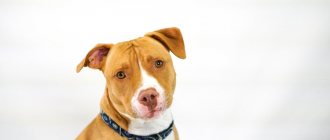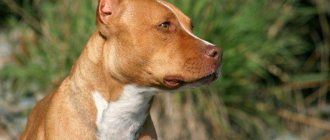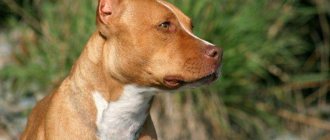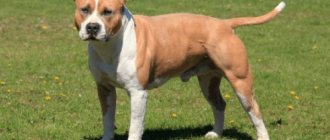Description of the American Staffordshire Terrier breed
Popularity 186th place among 263 dog breeds
Lifespan:
10-12 years
Breed group:
Fighting
Height:
males: 46-48 cm, females: 43-46 cm
Country of origin:
USA
Average price:
15-20 thousand rubles
Weight:
males: 25-30 kg, females: 22-25 kg
Latest articles Cat health
Rabies vaccination for cats: choice of vaccine, necessity, schedule 01/22/2022 4 0 0
Selection and adaptation
TOP 20 best cat breeds for families with children 01/22/2022 25 0 0
Dog appearance (standards)
Dimensions
Adult dogs range from 43 to 48 cm in height, with females only slightly smaller than males. Weight usually ranges from 25-30 kg.
Wool
The dog's coat is short, rather thick, and straight. It fits tightly to the body, shiny in appearance and hard to the touch.
Colors
The standard allows any solid color except white, as well as two-color, spotted, brindle.
Head
The Stafford dog has a wide, massive head with a pronounced transition from the forehead to the muzzle.
Teeth and jaws
The animal's jaws are wide and strong, have a scissor bite, and white teeth.
Eyes
The wide-set eyes are round in shape and dark in color.
Body and limbs
The Staff breed is characterized by a muscular build.
Dogs have a short back, a tucked belly, and a wide, powerful chest. The limbs have prominent muscles and are distinguished by strong bones. Arranged in parallel.
Tail
The short straight tail tapers towards the end.
Photo: https://pixabay.com/photos/staffordshire-bull-terrier-2379364/
Rock defects
The disadvantages of the breed include the following:
- light eyes;
- a long tail;
- barrel chest;
- caries;
- undershot;
- obesity;
- underdeveloped muscles;
- rough or light boned;
- cowardice;
- aggressiveness;
- mental instability.
Differences from pit bull (American pit bull terrier)
Amstaff and pit bull are two types of the same breed. They are sturdy, medium-sized dogs that are the epitome of strength. To see the external differences, just look at a photo of a Staffordshire Terrier and a photo of a Pit Bull Terrier. The Amstaff has a more proportional physique, while there is some disharmony in the appearance of pit bulls.
The American Pit Bull Terrier can last in a fight for up to three hours and, accordingly, is tougher than the Staffordshire Terrier.
Pit bulls are smaller in height and weight. But their heads are larger and their jaws are more powerful.
As for character, there are also differences. The Staff breed is more docile and less aggressive than pit bulls. Staffertiers remember commands better and are considered more diligent; their behavior shows a desire to please their beloved owner. At the same time, both breeds have high mental indicators.
Key facts
Despite the fact that the official name of the breed comes from the English county of Staffordshire, the United States is recognized as the country of origin. The abbreviated name for the American Staffordshire Terrier is Amstaff or Staff Terrier.
The lifespan of the American Staffordshire Terrier is at least 10 years and depends on maintenance and care.
A brief description of the American Staff Terrier breed is as follows: they are agile and strong animals, distinguished by amazing intelligence. Females are always smaller than males, but their appearance is no less impressive with 22-25 kg of weight and 43-46 cm of height at the withers.
The main characteristic of the Amstaff breed is its contradictory character, which has 2 sides of the coin and is determined by the chosen training method.
Breed traits
Breed traits (on a 5-point scale)
| American Staffordshire Terrier | |||
| Activity | in the house | 3.3 | |
| on the street | 4.7 | ||
| Obedience | training | 3.3 | |
| strangers | 3.3 | ||
| Domination | in family | 2.3 | |
| over dogs | 4.3 | ||
| Defending your territory | from people | 3 | |
| from dogs | 4.3 | ||
| Sociability | in family | 5 | |
| with strangers | 2.7 | ||
| with dogs | 2.7 | ||
| Concentration | in family | 1 | |
| in front of strangers | 2.7 | ||
| with dogs | 2.7 | ||
| Aggressiveness | in family | 1 | |
| to strangers | 2 | ||
| to the dogs | 2.3 | ||
| to cats | 3 | ||
| Family behavior | calmness | 4.3 | |
| demand for affection | 5 | ||
| excitability | 4 | ||
| playfulness | 4.7 | ||
| excessive barking | 1 | ||
| behavioral breakdowns | 3 | ||
| Tolerance for children | up to 4 years | 4.3 | |
| over 4 years old | 4.3 | ||
| Institutional use | watchman | 4 | |
| bodyguard | 3.3 | ||
This breed is often compared to the following dog breeds: Cane Corso, German Shepherd, Rottweiler, Doberman (Doberman Pinscher), Staffordshire Bull Terrier.
Photos of American Staffordshire Terriers:
American Staffordshire Terrier
American Staffordshire Terrier
History of the origin of the American Staffordshire Terrier
The country of origin of the breed is the USA, which transformed the Staffordshire Pit Bull Terrier originally from England. In the 19th century, the British, who emigrated to America, brought their fighting dogs to the New World. Bull Terriers absorbed the best qualities of strong Bulldogs and agile Terriers, which gave them an advantage in the ring.
The Michigan Kennel Club decided to improve the imported breed, softening the character of the animal. Not all citizens shared the love of dog fighting, noting the excessive cruelty of such entertainment. Pit bull terriers began to be taken for hunting and used as guards for farmlands and houses.
In 1936, through the efforts of American breeders, a new breed was created - the Staffordshire Terrier, which differs from the pit bull in its calmer behavior. Breeders were divided into 2 camps: some bred fighting pit bulls, while others continued to improve the exterior of the Staff Terrier. In the spring of 1971, the FCI recognized the new breed and registered it as the American Staffordshire Terrier. According to the accepted standard, the weight and height of the “Americans” exceeded those of the “English” by 5 kg and 8 cm.
Dogs arrived in Russia only at the end of the 20th century, but quickly gained popularity. With demand for unusual pets soaring, breeders have skimped on raising animals and neglected to monitor mental stability in an attempt to sell as many puppies as possible. For a long time, Staff Terriers retained the status of “killer dogs,” but responsible kennels and owners were able to defend the honor of the breed.
Appearance of the American Staff Terrier
General impression
Amstaffs are real athletes with a muscular body and well-developed bones, striking with their courage and excellent character.
The dog combines strength and agility. The photo of the American Staffordshire Terrier clearly shows that the stocky body is tightly built, but at the same time it makes an elegant impression.
Head
Staff Terriers have a voluminous and wide head of medium length with a flat, square-shaped skull. The stop is well defined, and the occipital protuberance is practically invisible. The length of the muzzle coincides with the length of the skull, and a clear relief can be seen on the cheek, chewing and parietal muscles. According to the standard, the description of the head includes:
- cropped or undocked rose-shaped ears;
- round dark eyes covered with pigmented eyelids;
- large black nose and well-opened nostrils;
- powerful and strong jaws with a scissor bite.
Individuals with flesh-colored lobes, light-colored eyes, an undershot, and a skewed lower jaw are discarded from breeding.
Neck
The head is set on a strong and muscular neck of medium length, evenly widening towards the withers. The skin in the neck area should not have folds or sagging.
Torso
Amstaffs have pronounced withers, long shoulder blades and well-developed muscles. The line of the back rises smoothly from a slightly rounded and sloping croup and reaches its maximum opposite the deep chest with rounded ribs.
Forelegs
The forelimbs are characterized by a parallel stance, elbows pressed to the body and round, arched paws.
Hind limbs
The muscles on the hind legs are more pronounced than on the front legs. The metatarsus is characterized by a moderate length.
Tail
Thoroughbred animals are distinguished by straight and short tails with a low rise and a smooth taper to the tip. When excited, the tail assumes a vertical position. Tail docking is not permitted.
Movement
In the video with Amstaffs you can watch their springy movements. Ambling is considered a vice for this breed. When moving, dogs should not pace or sway.
Wool
Short and coarse hairs create a thick coat that fits tightly to the body.
Color
In the pictures you can see many color options for the American Staffordshire Terrier: colored, solid, spotted. All are acceptable, but excessive amounts of white (more than 80%), liver, and black and tan are considered undesirable.
Breeders prefer animals with white and sable or black and white colors, and fanciers prefer animals with tricolor.
Size
It is clearly noticeable that females are smaller than males. The limiting height of an American Staff Terrier is considered to be 46 cm. For the weight of an Amstaff, the average norm is 25 kg. For males these are the minimum numbers, and for females these are the maximum. The standard clearly regulates the size of the American Staff Terrier.
Character of the American Staff Terrier
Amstaffs are intelligent and loyal animals with a very unusual character. Due to the low threshold of irritability, calmness is instantly replaced by aggression, so you have to work with this feature from childhood. With insufficient socialization, dogs can attack suspicious strangers and other animals who dare to encroach on their territory.
Timely training allows you to train Staff Terriers to be excellent nannies. They get along well with children, forgive them for pranks and willingly participate in joint fun. With such a pet, the owners are always protected. The dog is ready to fight for its family members to the last.
Living with an Amstaff requires following certain rules. If you are planning to have such a pet, then you should have the appropriate amount of knowledge behind you. Inexperienced owners will find the breed too tough. The obedient nature of the American Staffordshire Terrier is achievable, but you need to prove your authority. Otherwise, the Staff Terrier will begin to twist ropes out of its owner, and its behavior will become destructive.
“Americans” have a very developed intuition, which helps to identify an ill-wisher before committing a criminal act. Left alone at home, they will definitely protect the entrusted property from encroachers. When danger is detected, Amstaffs do not warn their opponent by barking or growling. They immediately rush to the target of the threat, leaving no chance for retreat.
With Amstaff you can live in a small apartment. He does not take up much space and feels more confident next to his owner. Keeping it outdoors in an enclosure on a chain is unacceptable and has a negative impact on the animal’s psyche.
Should you get an Amstaff?
A dog of this breed will be an ideal option for a balanced and consistent person, an experienced dog lover, or simply an active person with a stable psyche and patience. It is important to take the position of leader in the hierarchy of the pack and maintain it during puberty (sexual development). A family with children and pets will be complemented by a new nanny, companion and friend. The affectionate, sociable staff will guard, protect, play, take pity and comfort every member of the family.
As practice shows, you should not be afraid to “adopt” an adult dog. Amstaff is not a monogamist - he will be able to adapt to a new person, adapt to the habits and interests of a new family, accept and love its pets. But, in this case, the potential owner should find out exactly what educational problems this dog has in order to correctly assess his strengths and avoid tragedy.
Responsibility
The outstanding qualities of the Amstaff breed are attractive to many. But don’t forget that a serious dog means a serious responsibility. This breed is not for self-affirmation, not a tribute to fashion and not a toy - if you lose control over it, major troubles are inevitable.
“A dog, especially of this breed, is a mirror of the owner. If an Amstaff is aggressive, this is a mistake in upbringing, it’s not the dog’s fault.” Anna, amstaff owner
With improper upbringing or lack thereof, or insufficient socialization, a powerful, stubborn Stafford will sooner or later turn into a problem on a leash. There have been sad cases when a healthy pet had to be euthanized due to uncontrollability. An aggressive, powerful dog with such an impressive appearance can scare anyone, and can cope with any opponent.
When raising a Stafford, displays of aggression towards other animals should not be allowed. Photo: Miles Actually
Therefore, you should not allow even the slightest manifestations of zoo aggression in a puppy or young dog - otherwise, they will quickly get the hang of it. The owner will subsequently have to deal with the consequences of his frivolity.
Who definitely shouldn't get this dog?
Amstaff is not a dog for everyone. Such a powerful and active dog should not be owned by unbalanced, insecure, irresponsible or impulsive people, or homebodies. Beginner dog breeders will have to work on themselves - it is advisable to attend at least 10 classes with a dog handler. Not for the dog - staffs learn quickly, but in order to learn how to handle the pet themselves.
To separate fighting Amstaffs, conventional methods such as a bucket of water are not effective - in battle they often cannot unclench their teeth themselves. Experienced owners know that they can be separated in two ways:
- use breaking-sticks - pointed wedges made of hard wood
- two people simultaneously push dogs against each other by their hind legs. The mouths automatically open slightly and the dogs are pulled apart
This is a universal dog, but it will not tolerate passivity; it must be raised correctly. If you do not feel the strength for systematic daily upbringing, providing the animal with daily exercise, and are not ready to bear responsibility for the antics of a stubborn pet, get someone simpler.
Photo: Miles Actually
Despite preconceived notions about the breed, the Staffa is known and loved. “A broad dog soul”, “a man in a dog’s clothing” - this is how the owners, their friends and relatives - those who are at least a little familiar with this breed - speak about the American Staffordshire Terrier. Undoubtedly in need of proper upbringing and socialization, in skillful and kind hands the Amstaff will become the best friend and protector for the whole family.
Education and training
The upbringing and training of the American Staff Terrier begins from the first days of its appearance in the house. You will have to deal with the prejudices of people who have heard about “killer dogs” every day. Living with an “American” involves a significant amount of responsibility. Depending on how it is raised, an animal can become loyal and good-natured – or aggressive and dangerous.
Staff Terriers have high intelligence, so they quickly remember commands and easily perform even the most complex exercises. The main thing is to gain the respect and trust of your pet. Don't let him dominate, but don't dominate yourself either. Relationships must be partnerships. Never betray your dog or go back on your words. If the amstaff is given prohibitions, then they must be observed always and everywhere. Any relaxation is fraught with further disobedience.
Organize outdoor training from puppyhood. Socialization of a puppy is carried out through meeting other animals. Start communicating with dogs you already know who have a gentle character. The puppy should not be afraid of them, since fear and aggression are not far from each other. Staff Terriers remember their offenders for a long time and can transfer their hatred not to a specific animal, but to the entire breed.
During street training, do not enter into arguments with passers-by who speak unflatteringly about your pet. Speaking in a raised voice can be perceived as a threat to the owner. In this case, the amstaff will not think about whether the problem can be resolved peacefully, but will immediately attack the offender. Be calm and be sure to walk your dog on a leash and muzzle. A well-mannered pet shows strength only in cases of extreme necessity and with a direct command from the owner.
If you have difficulties with education, sign up for classes at a kennel club. The dog trainer will explain in detail how to teach a dog to obey its owner and how to wean the pet from performing unwanted actions. In group or individual lessons you can learn how to raise an Amstaff depending on its age. The best results come from paired exercises, where the pet works together with its owner.
American Staff Terrier Health and Diseases
The breed has strong immunity, but is predisposed to some diseases transmitted at the genetic level.
Possible diseases
Due to their large size, dogs often suffer from hip dysplasia. This disease can be inherited or be a consequence of obesity. For prevention purposes, do not overfeed your pet and monitor its physical activity. Before purchasing, be sure to ask the breeder about the health of the puppy’s parents. Severe development of the disease increases the risk of dysplasia in the acquired pet.
Amstaffs have a capricious stomach, so they often suffer from intestinal disorders. If your stool is abnormal, contact your veterinarian immediately. In addition to drug treatment, the doctor will recommend a special line of dry food that restores stomach function.
With natural feeding, dogs often develop allergies to the products offered, so here too it is better to choose high-quality hypoallergenic food. If changing food does not help get rid of itching, hair loss, redness and tearing of the eyes, then you will have to undergo a special test to identify the specific type of allergen.
Some animals may suffer from eye diseases such as cataracts or retinal atrophy. A timely visit to the veterinarian for preventive purposes (at least 2 times a year) will help to avoid these pathologies. In addition to examinations, be sure to treat your dog for parasites and follow the vaccination schedule recommended by your veterinarian.
Reproductive health
The first heat in females occurs at 9-12 months, but a dog can be bred no earlier than 20 months. Final maturation takes a long time, so giving birth too early can traumatize the animal’s psyche or harm the health of future offspring. Males can be bred strictly after 1 year.
Pregnancy lasts 57-65 days. After this time, at least 4 puppies are born. Sometimes 15 puppies can be born in a litter. Not everyone can cope with so many pets, so carefully consider all possible nuances. If breeding is not a priority, then take the dog for sterilization. Surgical intervention reduces the risk of developing cancer and diseases of the reproductive system.
Features of feeding and diet
Before purchasing, check with the breeder what to feed the puppy for the first time. The delicate digestive system reacts negatively to any changes, so the introduction of new products or a complete change of diet is carried out gradually.
The calorie content of meals should depend on the age of the dog. A young body requires more energy and vitamins to form the muscular skeleton, bone and joint tissues. The diet of older animals should be lower in calories, since metabolism decreases with age.
Ask your veterinarian what food to feed your pet if he has a food allergy. Highly allergenic foods include fish, corn and soy. Plant components are often included in cheap feeds, so such feeding is not recommended.
Natural nutrition should be accompanied by the use of vitamin and mineral complexes, since not all elements can be obtained from foods. Acceptable standards are agreed with the veterinarian, since a lack or excess of vitamins negatively affects the health of the animal.
The first complementary foods are given already 5-10 days after birth. Month-old puppies are fed milk, semolina porridge, soup with meat broth and ground pieces of meat. From 2 months, cartilage and boiled non-tubular bones are added to the diet. The proposed bones should be soft, since the rough structure harms the teeth and provokes the development of pulpitis.
Care and maintenance
Keeping and caring for Staff Terriers is not complete without a daily walk. Active outdoor activities are very important for the breed to maintain physical fitness. With low loads, the animal’s weight increases and joint problems worsen. Try to walk for at least 2 hours twice a day. With a flexible work schedule, the number of walks can be increased up to 3 times. Try to take your pet to nature, where he can be given free range.
Caring for an Amstaff is very simple, since the dog is not a long-haired breed. Seasonal shedding involves more frequent brushing, and its duration depends on air humidity. The drier the air, the longer the dog sheds. The coat should be combed 1-2 times a week with a special massage brush, which removes dead hair and does not injure the coat. In addition to brushing, don't forget:
- Wash your dog whenever it gets dirty. Frequent washing removes the natural fat layer, peels the skin and leads to dermatoses. Bathe your entire pet no more than 2 times a year. The rest of the time, it is enough to wash your paws and wipe the skin with a damp towel.
- Check the condition of your eyes and ears. Amstaffs are no strangers to ophthalmic diseases, so clean your eyes daily with a cotton swab dipped in chamomile. Plain water is suitable for cleaning your ears. The main thing is not to use cotton wool or cotton swabs. The first instrument can injure the mucous membrane of the eye, and the second one can injure the eardrum.
- Clean your teeth with a special dog toothpaste. Oral diseases cause serious complications on internal organs, so do not allow the development of caries or pulpitis.
Staff Terriers do not need special haircuts, so you can save on visiting a grooming salon. It is also better to trim the claws on your own, since the dog is ready to endure such an unpleasant procedure only at the hands of the owner. If you are afraid of injuring your pet, ask your veterinarian for help. The doctor will show you how to care for the claws without harming the animal’s health. After a short training, repeating the procedure at home will be quite simple.
Pros and cons of the breed
The advantages of the breed include the following:
- ease of care;
- fearlessness;
- excellent instincts, detective abilities;
- devotion to the owner;
- cleanliness;
- no tendency to bark excessively;
- good health;
- mind;
- endurance;
- force.
Disadvantages of the breed:
- tendency to aggression;
- the need for serious education;
- desire for dominance;
- not suitable for inactive people and beginners.
Tips for choosing a puppy
It is safer to make a safe purchase from a large, licensed nursery with good reviews. Don't be tempted by the low prices offered by sellers at the bird market. Saving is fraught with the purchase of a sick or outbred animal with destructive behavior. It is impossible to retrain such a dog.
Before purchasing, request detailed advice from the nursery staff. The staff should familiarize the buyer with all the nuances of the breed and show possible options for future pets. Before making a choice, carefully study:
- Proposed documents. Cost and other important points must be taken into account in the contract. Along with the puppy, the new owner is given a veterinary passport that records the vaccinations given, a pedigree and a puppy card.
- Appearance of four-legged pupils. American Staffordshire Terrier puppies should have clear skin, velor coat, clean ears and eyes. Animals with a distended belly should be isolated from others.
- Parental behavior. Adult animals should boldly make contact with strangers. Cowardice or aggression are unacceptable.
Breeders advise taking a closer look at future pets in advance. At 1 month, conformity with the exterior becomes more noticeable, and the puppy can be conditionally assigned to a certain class. If at this age any deviations from the standard are noted, then it will not be possible to correct them in the future.
Up to 8 months, light-colored puppies are allowed to have blue eyes and slight pigmentation of the eyelids, nose and lips. This is why buying a dog with white fur involves greater risk.
How to choose a puppy?
You should purchase a puppy from a specialized nursery - this guarantees the purchase of a purebred and healthy individual. According to an advertisement or on the market, there is a risk of purchasing a mixed breed or a dog with any pathologies.
The puppy must be carefully examined; it must have:
- clear round eyes with dark irises;
- scissor bite;
- shiny coat without dandruff;
- clean skin without irritation;
- rounded muzzle.
NOTE!
Increased watery eyes, discharge from the nose or ears, a bloated stomach, lack of appetite, or lethargy may be signs of illness.
It is better to buy a puppy when he is 2-2.5 months old - at this age he is no longer physically dependent on his mother and will easily cope with the move and adapt to the new home.
When choosing the gender of your pet, you should know that females become more attached to their owner, they are more affectionate and easier to train, the only disadvantages are regular heats and possible changes in behavior during them.
Males, in turn, are more stubborn, they strive to mark territory and will always compete with the owner for the place of leader.
How much does an American Staff Terrier cost?
When determining how much a puppy costs, the seller takes into account all the costs incurred (sterilization, vaccinations, feeding the puppies) and the prestige of the established class. The price of an American Staff Terrier starts from 12 thousand rubles. For this money you can buy a pet-class representative with some deviations from the established standard.
The cost of breed-class dogs ranges from 18 to 25 thousand rubles and allows you to breed the breed. The maximum price is typical for representatives of the show class - future winners of exhibitions or sporting competitions. For such a handsome man you will have to pay at least 25 thousand rubles - or even more.
Nurseries always advise choosing a future pet based on its future fate. You should not deprive an animal with an exceptional exterior of its well-deserved fame if participation in exhibitions seems too boring and difficult. Most owners buy pets for the soul, and in this case the pet category is the most reasonable choice.
Do you like the article? 0
What does the price depend on?
The cost of Staffordshire Terrier puppies varies widely. The following factors influence price formation:
- Availability of pedigree.
- Age.
- Purebred.
- Having titled parents.
- Color.
- Availability of veterinary documents (cards, vaccination passports).
- Class.
- Health status.
- Place of purchase.
- Seller's pricing policy.
Purebred individuals are more expensive than mixed breeds. The presence of titled parents, pedigree, veterinary passport and card makes the puppy more expensive.



